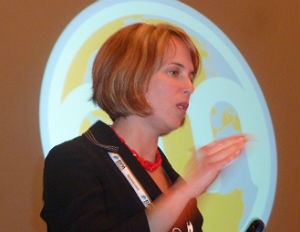
The B2B Track during day one of Content Marketing World in the “Gold Room” was jam packed for each session. That includes this session about Corporate Blogging and Globalizing your Editorial with two speakers from SAS and Intel. Since the topics were so different, I decided to split the liveblog post into two. This is part one.
Speaker: Alison Bolen @alisonbolen Content Editor SAS
Presentation: Results-Driven Blogging for B2B Brands
Alison’s presentation focused on corporate blogging and the blog program at SAS (a $2 billion business analytics company).
The history of SAS and social media started in 1976 with the first SAS Global Forum, 2004 internal blog program, 2006 SAS communities launched, 2007 the first external blog launched and in 2011 the transition to the WordPress platform. You can find SAS blogs here: blogs.sas.com
Alison works in the Public Relations organization at SAS along with 8 other corporate journalists.
How to Grow a Corporate Blogging Program
Develop a strategy: Find out where the current corporate strategies are and find a hook into them. For the SAS blogging program, there were 3 main goals: to align with PR, Marketing and Customer Support.
Blogging supports each stage of the funnel:
- Identify the problem / opportunity
- Research solutions
- Evaluate
- Consider
- Purchase
SAS blog efforts are meta data enabled: by persona, by category, by industry. For content to be relevant and valuable it must be persona based and aligned with steps in the buying process.
The next step in corporate blogging strategy development is to find the right content. Ask these important questions: Where do stories live? (Word Docs, PPTs, Videos, Live Events) Where does knowledge live? (Sharepoint, White papers)
Now it’s time to find the right people. Alison gave the example of two SAS bloggers that write for distinct audiences.
Blog Planning with Monthly Assignments. All posts are due on a specific date each month. The most timely posts are published first. Breaking news and fillers are published as relevant. A schedule ensures there is content to work with each month.
Another planning option is to focus on one specific topic. For example, each Quarter, focus on a specific topic for each blogging contributing to that particular blog.
Another angle on corporate blog planning involves themes every week. Example: Monday (Getting Started Articles) Wednesdays (Topics the Blogger is Trying to Learn & Documenting that Process) Friday (Posts in reaction to a particular topic from other blogs)
Tap Internal Subject Matter Experts: If the organizational structure supports it, you can divide blogging assignments by areas of specialization. Example: 16 Think Tank team members for healthcare at SAS that includes authors who specialize in specific areas. They are assigned to blog on their area of expertise at least once a month.
Have a blog that new bloggers can contribute to in order to show their commitment. SAS also has an internal blog network of 700+ bloggers that also acts as a testing ground.
If you have a group blog, you must have an editor. No assignments and nobody in charge = NO CONTENT. A blog editor is a content chaser, people watcher and project manager – not necessarily a corporate communications person.
For events, plan across blogs as needed. Map topics and aspects of the events to be covered by the different blogs in your organization to ensure coverage.
If blogs don’t work out, retire them.
Coach and advise, don’t micromanage. Be patient with different learning styles. Don’t pre-judge and expect too much.
Results: Customer Support – Positive comments and links to your blogs.
Results: Marketing – Bloggers invited to speak at conferences, getting calls from journalists, posts picked up by industry publications and bloggers getting invites to write books
Results: The New PR – Journalists contacting SAS after seeing blog posts. It’s the new PR.
Results: The Blog is the top news source on the sas.com website. In fact. compared to other news pages on the SAS site, the blogging effort is blowing other content out of the water in terms of traffic.
I think Alison gave some really useful ideas for blog content and planning. One of the most common objections I hear from companies that really should be blogging (and not all companies should) is that they have difficulty with creating content on an ongoing basis. It’s a big mind shift and kudos to SAS for having 8 Corporate Journalists on staff.


